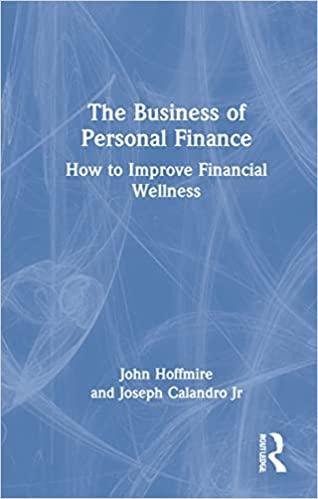Question
1. Which of the following statements is true about common stocks that do not pay dividends? a. they have a value that equals the book
1. Which of the following statements is true about common stocks that do not pay dividends?
a. they have a value that equals the book value of the firm's assets
b. they have a value that equals the market value of the firms assets
c. they can be valued using ratios like the P/E ratio
d. they have no nvalue since they do not generate any cash flows
Questions 2 and 3 concern the information below:
Patrick Company expects to generate cash flows of $120,000 per year forever. The firm's required return is 12 percent, the market value of debt is $700,000, the market value of preferred stock is $300,000, and the company has 100,000 shares of stock outstanding which sell for $10 per share. Beta for this stock is 1.6, the risk-free rate of return is 2.25% and the market risk premium (rm-rf) is 5.5%
2. the proportion of debt in patricks capital structure is:
a. 30%
b. 50%
c. 70%
d. indeterminate
3. The required return of Patrick's stock is:
a. 10.9%
b. 7.75%
c. 5.5%
d. 2.25%
4. You own a mutual fund with an expected return of 10% per year and a standard deviation of returns of 12% per year. You are considering adding another stock to your portfolio. The new stock has an expected return of 10% per year and a standard deviation of returns of 20% per year. The correlation of returns between the new stock and the existing mutual fund is positive, but low. What can we conclude about adding the new stock?
a. it would be a bad idea, since your risk would be unchanged, but your portfolio returns might be reduced
b. it would be a bad idea, due to the higher risk of the new stock
c. the impact of the new stock on risk and return is indeterminate without knowing the new stocks beta
d. it would be a good idea, due to the impact of diversification
5.In the capital asset pricing model, the beta coefficient is a measure of what?
a. unsystematic risk
b. non-aggregated risk
c. business-specific risk
d. nondiversifiable risk
6. what is the required return of stockx, with a beta of 1.5, a risk-free return of 2 percent, and an expected market return is 10 percent?
a. 1.5%
b. 8.5%
c. 14%
d. 17%
7. in order to determine if an asset represents a good buy, a firm should use ____ as a discount rate in its evaluation.
A. the least costly source of financing
B. the most costly source of financing
C. the weighted average cost of all financing sources
D. the expected market rate of return
8. The WACC represents:
a. the average required return of all the firms suppliers of capital
b. the required return of the firm overall
c. a target return on assets for the firm
d. all of the above
9. a tax adjustment must be made in determining the cost of_____
a. long term debt
b. common stock
c. preferred stock
d. retained earnings
10. a small business borrows money from a bank at an interst cost 12% per year. The firm has a marginal tax rate of 40 percent. the after tax cost of debt is_____.
a. 4.8 percent
b. 6.0 percent
c. 7.2 percent
d. 12 percent
Step by Step Solution
There are 3 Steps involved in it
Step: 1

Get Instant Access to Expert-Tailored Solutions
See step-by-step solutions with expert insights and AI powered tools for academic success
Step: 2

Step: 3

Ace Your Homework with AI
Get the answers you need in no time with our AI-driven, step-by-step assistance
Get Started


